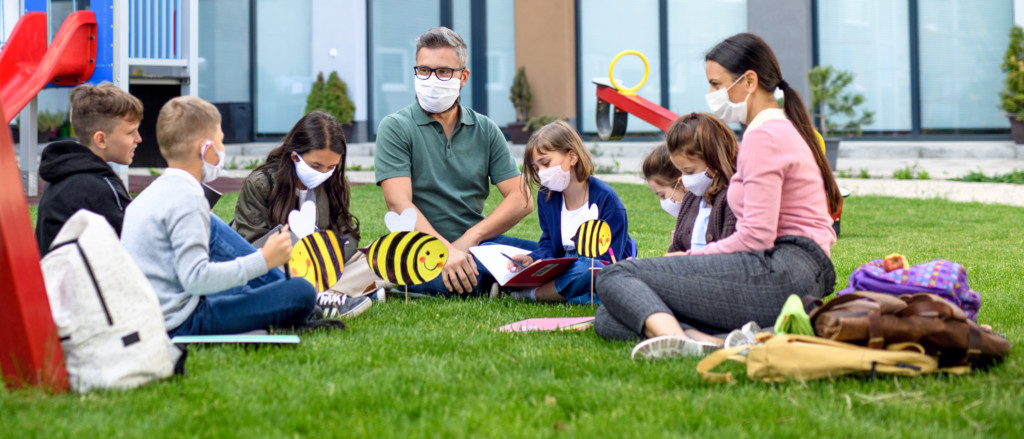 Editor’s note: This commentary from Bruno V. Manno, senior adviser for K-12 Education at the Walton Family Foundation, explores the myriad ways the global pandemic is birthing impressive innovations and alternatives so learning can continue.
Editor’s note: This commentary from Bruno V. Manno, senior adviser for K-12 Education at the Walton Family Foundation, explores the myriad ways the global pandemic is birthing impressive innovations and alternatives so learning can continue.
The COVID-19 calamity is motivating families to seek alternatives to their child’s current school and inspiring entrepreneurs to start new enterprises that help families manage this unique situation.
As luck would have it, public and private school choice policies enacted in many states over the last 30 years advance this innovation and invention. Meanwhile, some governors are using their state’s new COVID-19 federal dollars to give parents financial support when needed as they move to these new education programs.
Three of the newer innovations parents are choosing are micro-schools, family PODS and virtual charter schools.
Micro-schools are one-room schoolhouses, typically mixed-age groupings of 15 students or less that meet in homes, churches, community centers or workspaces. They often use today’s technology to support instruction, with teachers — or other learning guides — using different instructional approaches, including place-based and experiential learning.
Some micro-schools are private and charge tuition, though 29 states (plus the District of Columbia and Puerto Rico) have school choice polices that allow families to use public dollars to pay for private school expenses. Other micro-schools are tuition-free public schools; they are created using some aspect of a state’s charter school law.
Arizona-based Prenda, a network of micro-schools, has grown from seven students in one neighborhood in 2018 to more than 200 schools. Its website traffic increased 737% in June compared to activity for June 2019. The organization works with public charter schools to provide tuition free micro-schools. It also accepts funds from Arizona’s Education Savings Accounts program, which allows families to use public dollars for private school costs, tutoring, online learning and other educational expenses.
Another innovation is the now much-discussed Parent Organized Discovery Sites, or PODS, typically engaging three to six families who employ one teacher for their kids. Alternatively, parents teach, hiring a college student or other adult to assist. Some PODs provide scholarships for low income families. And in some states, educational expenses associated with PODs can be paid for with public dollars.
Pandemic PODS combine tutoring and childcare so students socialize and learn with friends. A Facebook post documents how “within 48 hours … thousands of parents [created] Facebook groups to form … PODS.” The San Francisco school district will open 40 district PODS in libraries and community centers this school year.
In Columbus, Ohio, the YMCA is offering PODS for students ages 5 to 16 who are attending school virtually. Students can arrive as early as 6 a.m., with learning sessions starting at 8 a.m.
Public charter schools are another option, coming in many forms, including online learning. Families are choosing virtual charters as “brick and mortar” schools remain closed or because they’re wary of sending kids into school buildings.
Oklahoma’s Epic Charter Schools is a virtual school enrolling 38,026 students. It’s the largest school system in the state — surpassing Oklahoma City’s and Tulsa’s districts — adding up to 1,000 students a day. Students who enroll in Epic’s online program have access to a $1,000 “learning fund” to use for everything from karate lessons to art classes. The school manages the money and parents must choose from approved vendors.
Meanwhile, Florida Virtual School is a tuition-free school that works with public, private, charter and homeschool families and school districts nationwide. It has seen an increase of 64,107 course requests in its Flex program since July 1, representing an increase of 93 percent. Full-time applications have increased by 5,738, or 177%, over the prior year since registration opened in March.
New enterprises are also being founded.
SitterStream is a startup created at the beginning of the pandemic. It offers on-demand babysitting and tutoring to students, individually or in PODS. It has partnerships with small and large businesses who provide these services to employees, with Amazon one of their corporate clients.
Transportant, a high-tech school bus company, makes “school buses as smart as your phone.” With the onslaught of the pandemic, it began working with school districts to make buses rolling Wi-Fi hotspots. It now provides high speed internet services for an entire street or apartment building to students who lacked access.
During the pandemic, states also are providing financial support for families seeking new education options for their children. The federal CARES Act provides discretionary funds for governors to support innovative education programs and services, fostering creativity and enterprise.
Oklahoma Gov. Kevin Stitt is using $30 million from the CARES Act’s Governor’s Emergency Education Relief Fund to create a $12 million “Learn Anywhere Oklahoma” program so students can access online content with a teacher; an $8 million “Bridge the Gap” digital wallet program offering $1,500 to more than 5,000 low income families to purchase curriculum content, tutoring, and technology; and a $10 million “Stay in School” fund providing up to $6,500 to over 1,500 low income families with a pandemic-related job loss so their children remain in their current private schools.
Governors Henry McMaster of South Carolina, Chris Sununu of New Hampshire and Ron DeSantis of Florida announced similar programs for low-income families wanting to enroll their child in a private school.
COVID-19 has turned school re-openings into disarray. But creative and determined parents, entrepreneurs and policy leaders are responding with impressive innovations and alternatives so learning can continue.


